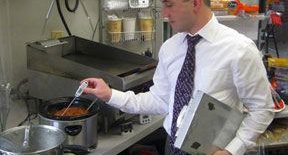By John Mortimer and originally published in Innovative management blog
The transformation possible, when applying a systemic design thinking approach to an enforcement service – Food Safety
Introduction by EE Magazine Staff:
If you do nothing else, just look at the two videos
customers’ view managers’ view
 Introduction
Introduction
Enforcement services are recognised as those public sector services that are designed around stopping people from doing something; littering, noise, anti social behaviour are good examples.
The services are always backed by legislation that defines the limits of what is acceptable, and those in the service often see themselves as having to ‘police’ or defend something.
Typically, for most services this is a warning, then a fine. Interestingly it is often the case that staff wear uniforms of some type.
Below is an example from a Food Safety Team from England, using a systems thinking approach to challenge their current way of working.
Food safety
Summary
• Service improved from requiring special measures to excellent
• Service ethos changed from enforcement to helping
• Waste reduced by 75%
• Cost saving 24% overall
• FTE reduced by 2
• Nationally recognised transformation
• Customer feedback changed from suspicion to welcoming
The Details
When looking at food safety, if you ask them what their job is, it is to
enforce food standards on restaurant owners.
They have the ability to fine, or even to take the owner to court, if they think it is appropriate. For the restaurant owner, the experience is never one that they enjoy – the officer suddenly turns up at my door, telling me that I am here to inspect you.
What Used to Happen
- “Please give me a place I can change my clothes”
- I wait, and worry about all thin things I have not got right in my kitchen.
- The officer comes into my kitchen all dressed in white, with a clip-board. They ignore me, and look into every corner of my kitchen.
- They ask me for my staff training records, and I have two new staff who have not done the training.
- After 30 minutes, they take me into my office, and they tell me what I am doing wrong.
- The inspector did not see what I was dong right, that I have been very busy this week, and that I am trying my best. I hate them, I try and hide things from them.
When the officer arrives, they put on a white outfit, and walk around the kitchen inspecting what they want to see. The restaurant owner just has to watch. And the officer usually has a list of items they expect to see; clean surfaces, training records & certificates, proof of inspections, and so on.
At the end of the visit the officer will go back to their office, and type up a reference document that lists all the items that failed the inspection. Each problem will include sections from the legislation, and a warning of when they should be completed. The tone of the letter is very standard and official – and the wording must be written assuming that the letter might be shown in court.
What They do Now
The same group of officers, after they have transformed their approach, did something very different. Firstly, they realised from a systemic perspective, that their purpose was to help restaurants create safe food – not to fulfil a pre-determined list of criteria.
- They now first phone me, and ask when it would be a good time to visit.
- They arrive, they get changed, and we have a conversation about what issues I am facing. I tell them about the two new staff, and how busy I have been.
- They go to the kitchen and simply watch what is going on.
- Then, we have a further conversation and they show my staff a few things that they ask about.
- The inspectors write down a few points that I should take care of, and ask me if I need any help with them.
Back in the office, there is the biggest change; this is what has changed:
- Paperwork has reduced by 80%. We only record what we need we need to, and we don’t type formal letters to the restaurants.
- We are not interested in the old measures, so we don’t need to record each problem on the measures system.
3. The number of activities we used to do in an inspection flow was 134, now it is 31.
4. The purpose has changed from checking, to helping people when they need help. Our motivation has gone right up – I enjoy my work.
5. If a restaurant manager has a problem, they will now call up the inspector and ask them for advice.
“We can now do two visits in one day, not just one.”
Now have a look at these videos to see what it was like
The customers’ view The managers’ view
As an enforcement officer, it is now up to me to decide what I do and how I do it, for each situation I find myself in. It is great to be able to put into practice my knowledge, and help people.
In the office we have regular sessions, where we discuss what were doing, and what techniques we have learned. If any of us ever need help, all of us are there at the end of the phone – but the most helpful person is my manager.
Enforce principles of working:
We follow instructions
We ignore the individual issues with the person
This is just a job, managers dont like me.
Help me principles of working
We understand the customer, and their problems
We adapt and do the right thing for them
I enjoy my job, it helps people, they like me.
The Method
The approach that was used was to take a team of inspectors and the manager through a series of tasks – they started by understanding what mattered to the restaurant manager. They also mapped out all the activities that they took to complete a visit, it was 134 steps!
They then set about experimenting with a new purpose – to help the managers create safe food. The team realised they had little idea how to actually do that, so they worked with one restaurant, and then another, until they had learned a new set of techniques and approaches that became their new way of working. They discarded those activities that they deemed not necessary.
The Implications
Think of those public services that are ‘enforcement’ – that fine, chase, force people to do certain things. Imagine what would be the implications to the community if those services, instead of we enforce, became we help.
Republished with permission of the author.
Featured Image/graphic link added by Enlivening Edge Magazine





I thought it would be useful to some people reading this, to understand a little more about the approach I took. I have just added a section in the same article on my website, that goes into more detail. Simply go to this list and navigate to the bottom of the article. https://www.improconsult.co.uk/my-blog/a-systems-thinking-case-study-food-safety-inspection-service
Any feedback would be welcome.